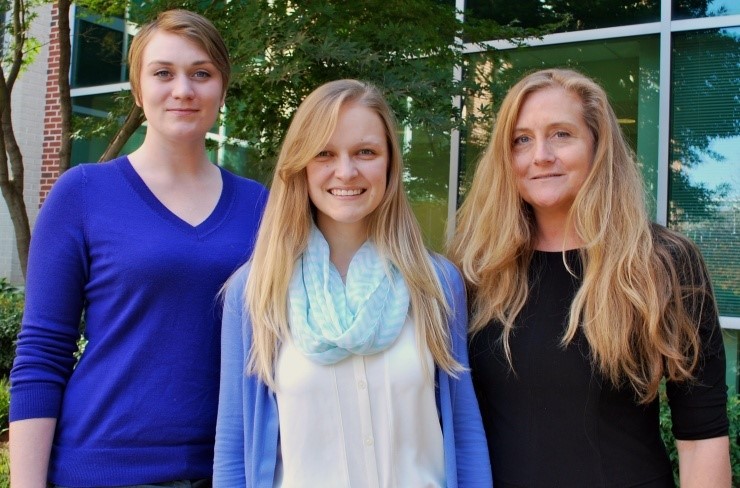Turning Ideas Into Reality

The Coulter Translational Partnership team: (L-R) Shawna Hagen, Katie Merritt, and Rachel Hagan.
Coulter Translational Research Partnership supporting early stage biomedical projects
Six promising biomedical research projects from Georgia Tech and Emory University, including several based in labs at the Petit Institute for Bioengineering and Bioscience, are receiving critical early-stage support in the form of funding and operational guidance through the Coulter Translational Research Partnership Program.
The program, partnering with the Wallace H. Coulter Department of Biomedical Engineering at Georgia Tech and Emory, provides annual awards to research teams working on products with commercial potential that meet a significant unmet or underserved clinical need.
This year’s round of seed funding, totaling more than $1.1 million, will accelerate the progress of five new research teams and one team that is seeing its funding renewed for a second year. But the hope for, and the interest in these projects extend well beyond this year.
“The goal for all of our projects is to get follow-on investing, funding from outside the university setting,” says Rachel Hagan, program director for the translational research partnership at Georgia Tech/Emory. “We haven’t accomplished the job until that happens.”
Helping to do the job of guiding these teams through the translational process are Hagan and two program managers in her office, Shawna Hagen and Katie Merritt, along with a team of four biotech entrepreneurs, “people who have been through the process before, from diverse professional backgrounds,” Hagan says.
“We basically become part of the interim business team,” she adds. “We help them meet milestones, traveling with them to conferences to make sure they talk to the right people in the right ways. It’s not just mentoring. Sometimes we lead the charge. It really is a hands-on coaching process that breeds serial innovators.”
It’s a process that actually begins before the final teams are selected for the award. Hagan estimates that 50 teams applied for the program. While only a handful make the final cut, all of the teams gain significant insight in how to present their products to potential investors, which includes the Coulter program’s oversight committee.
“We want every project to have a fair opportunity to get selected on its own merits,” says Hagan, whose team helps prepare the research teams before they present in front of the committee. “We don’t want them to go into this cold turkey and unprepared.”
This year the committee (which is composed of Emory doctors, Georgia Tech biomedical engineers, industry experts, venture capitalists, entrepreneurs, angel investors and technology transfer experts from each school) selected the following projects:
- Ad Cor: A drug delivery platform for localized delivery of therapeutic-seeded hydrogels to the pericardial space. This is the second year of funding for Ad Cor (known last year as Levit Catheter). Principal investigators: Andrés García (Georgia Tech/Petit Institute researcher), Rebecca Levitt (Emory).
- CAR T Cell Manufacturing: Cell processing and treatment technologies that will enable better manufacturing and functionalization of therapeutic T-Cells for patients with Diffuse B Cell Leukemia. Principal investigators: Todd Sulchek (Georgia Tech/Petit Institute researcher), Edmund Waller (Emory/Petit Institute researcher).
- FraudScope: Provides intelligent claims analysis to help identify, address, and mitigate payment of fraudulent healthcare billing. Principal investigators: Musheer Ahmed (Georgia Tech), Mustaque Ahamad (Georgia Tech), Richard Duszak (Emory).
- MitraPlug: A transcatheter implant that seeks to “plug” the fluid path, which is seen in patients with mitral regurgitation. Principal investigators: Murali Padala (Emory/Petit Institute researcher), Eric Sarin (Emory).
- Plasma Cell Media: Novel media that dramatically increases the time in which plasma cells can survive in vitro. Principal investigators: Ronghu Wu (Georgia Tech/Petit Institute researcher), Frances Eun-Hyung (Emory).
- Subconjunctival Injector: A device which allows for safe, efficient, and controlled delivery of ophthalmic therapeutics to the subconjunctival space of the eye. Principal investigators: Ross Ethier (Georgia Tech/Petit Institute researcher), Rand Allingham (Duke University).
“We also encouraged a few teams that didn’t make the cut this year to come back and apply next year,” says Hagan.
The translational research program has fiscal roots in the $25 million grant the Wallace H. Coulter Foundation made to the Georgia Tech-Emory biomedical engineering program in 2001. This gift resulted in naming of the Coulter Department, while also targeting $10 million toward the ongoing support of translational research.
Including the Georgia Tech-Emory department, there are 15 universities with translational research partnership programs supported by the Coulter Foundation, including Columbia, Duke, Johns Hopkins, and Stanford universities. And many of them have called on Hagan and her team as a resource.
“We get calls regularly from other universities who want to know how we implement the program. It’s become a popular model in the U.S.,” Hagan says.
In fact, the National Institutes of Health (NIH), the largest funder of biomedical research in the world, and the Wallace H. Coulter Foundation has called on Hagan and her team to implement the educational and mentoring aspects of the program for some of the NIH’s SBIR and RO1 grantees.
“They want a more effective plan to make those NIH dollars really work,” Hagan says. “The NIH is after the same goals that we are in the Coulter partnership – they want these companies to be successful.”
CONTACT:
Jerry Grillo
Communications Officer II
Parker H. Petit Institute for
Bioengineering and Bioscience